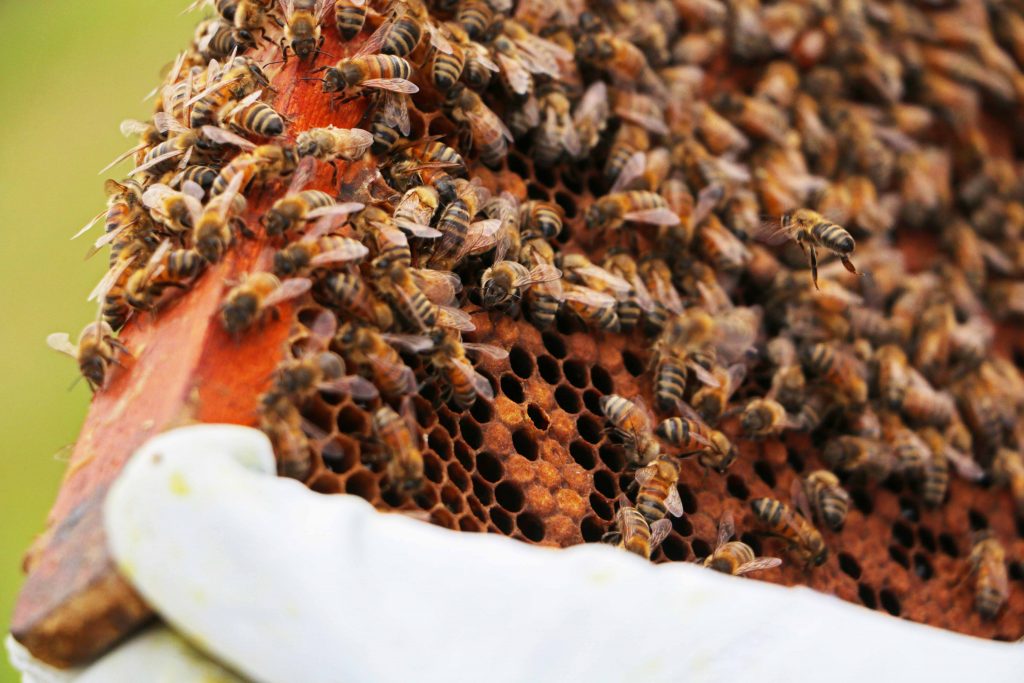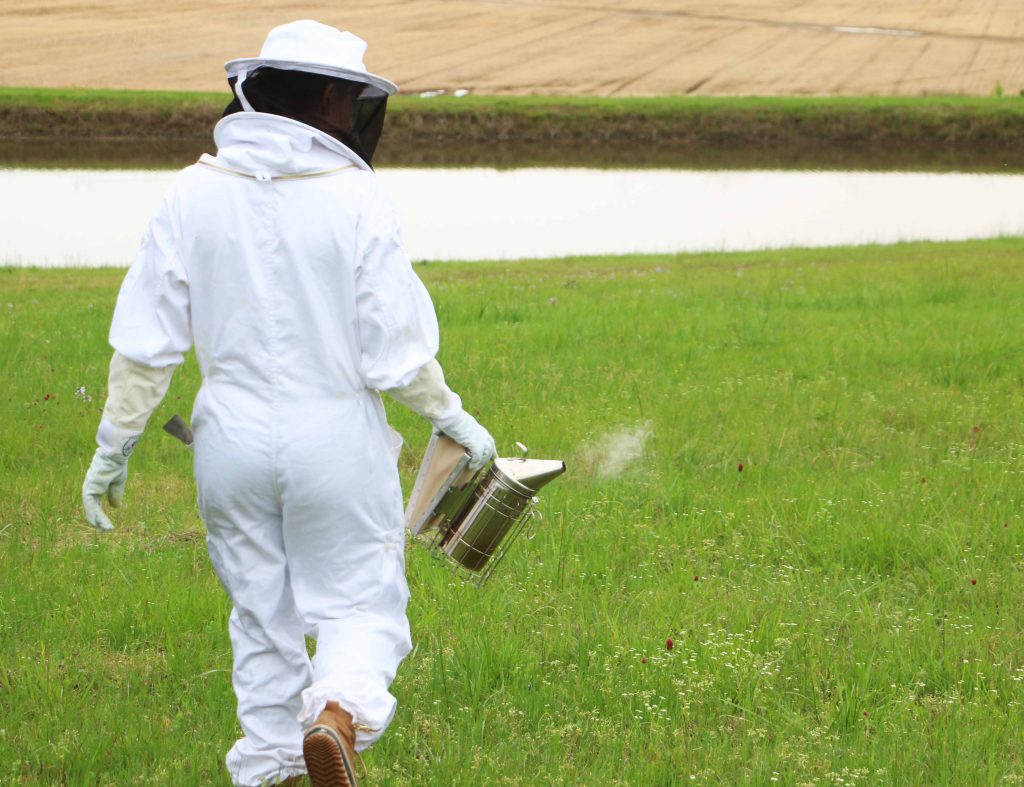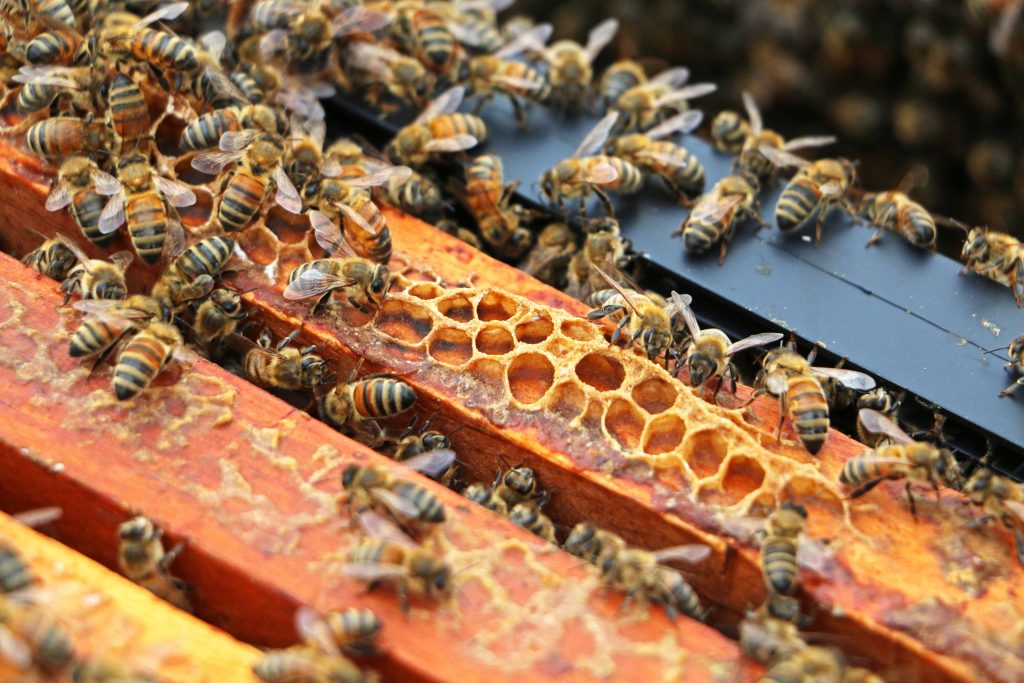To my surprise, I couldn’t hear the bees buzzing until I got within about five feet of their homes: four hives populated with roughly 6,000 to 8,000 bees per hive. And there wasn’t much other noise, just the gentle chirping of birds and the snap of photography editor Katherine Butler’s camera.
Caroline Bailey, the president of the Ole Miss Beekeepers Club that populated these beehives — their first — over the past week, said the bees were buzzing a bit differently because of the cooler weather. A storm was on its way.

“If you hear them today, it’s a bit of a louder buzz,” she said. “Normally it’s just a hum.”
We were out on the farm: a piece of property two miles past Oxford city limits. It was donated to the university with the stipulation that the land stay undeveloped. Besides the club’s hives, there was a small pond and two fields — one planted with cotton, one with beans.
Last Thursday, Bailey drove to Myrtle, a tiny town about 25 minutes from Oxford and the home of Red Belly Bee Farm. The farm, run by Bob Russell, donated two of the bee nucs, small bee colonies that were used to populate the hives.
Russell also helped teach the club how to actually do the work of beekeeping. In exchange for his advice and nucs, the students helped out at Red Belly, extracting honey and stocking nucs.
“(Beekeeping) takes management, learning from books, learning from observation. It takes work. … There are good days and bad days, ups and downs,” Russell said. “That sounds good to me for college kids to learn about.”
After Bailey got the bees, she drove them back to Oxford. She put on a relaxing playlist for her insect companions, more nervous that they would be uncomfortable than that they would escape and sting her. She then took the bees to the property to get acclimated to their new home in Lafayette County.

The next day Bailey, along with four other club members, went to the farm to populate the hives. On a hill overlooking the fields, they put on their protective white suits — everyone sort of looked like astronauts.
“You’re probably gonna get stung anyway,” Bailey said. “But the likelihood goes down a whole lot when you suit up and everyone, you know, checks for holes, makes sure everything’s zipped right and velcroed.”
Down the hill, close to the pond, they carefully pulled the five frames (panels of wood lined with artificial honeycomb) from each nuc and transported them to the ten-frame hives.
As the students moved them, the bees did a dance. Bailey said they “stick their butts in the air and shake it around” to help navigate from place to place. Eventually the insects were all settled in their new habitat.
“I’m assuming this is what it would feel like watching your kids go off to kindergarten or graduating high school or going to college or something like that. That’s what I see it as being,” she said.

But, as wonderful as that day was for Bailey, it was also a bit nerve-wracking. None of the five there on Friday had ever actually populated a hive before. And their campus mentor, Honors College Dean Douglass Sullivan-Gonzalez, wanted them to do it on their own.
“Right before we opened the first box, we were all like, ‘What do we do?’ … No one wanted to be the first one to start,” Bailey said. “But once we got going and actually got all the bees in the hive and made sure we didn’t squish the queen or anything, we were all just elated.”
That feeling of elation was the end of a yearlong process for the club.
They gathered over 300 pounds of equipment. They spent hours researching how to beekeep and protect their bees from the Varroa mite’s harmful virus. They cultivated close relationships with other Mississippi beekeepers, including Russell, Mississippi State University research professor Jeffrey Harris and the folks at Pennington Farms, who donated two more nucs to the club.
Pennington Farms linked up with the club because they have two children who attend Ole Miss. Katelyn Pennington is one of the few club members with beekeeping experience.
“I’ve grown up working with honeybees all my life, so I know a lot about them and the process of beekeeping already,” Pennington said. “I try to share what I know with everyone in the club.”
From here, the bees will do most of the work on their own. Bailey said that she and the other members will check on the hives once a week but that taking the bees out more than that would just make them angry.

Come next spring, the hives will have their first honey flow, followed by another in the fall. Bailey said they’ll let the bees keep the first flow and let the club taste the second. Perhaps, years from now, they could sell the honey for a fundraiser.
But for now, Bailey hopes for something much simpler.
“That they live,” she said, laughing. “That’s my first goal.”






